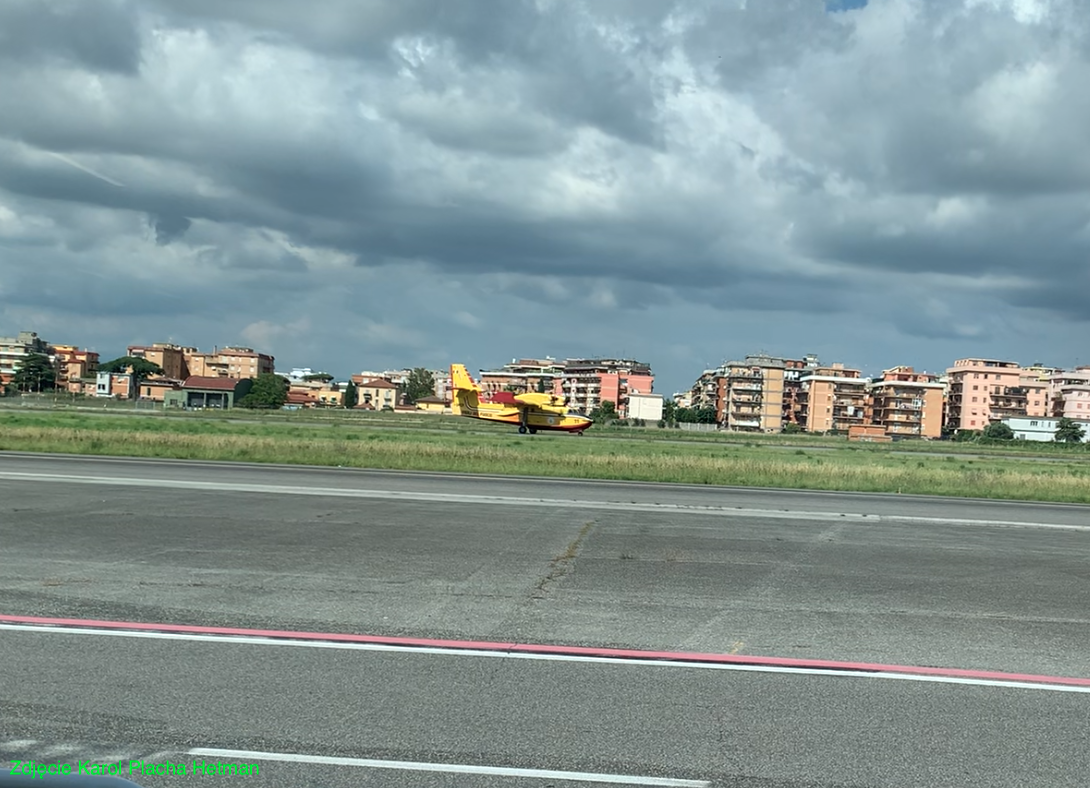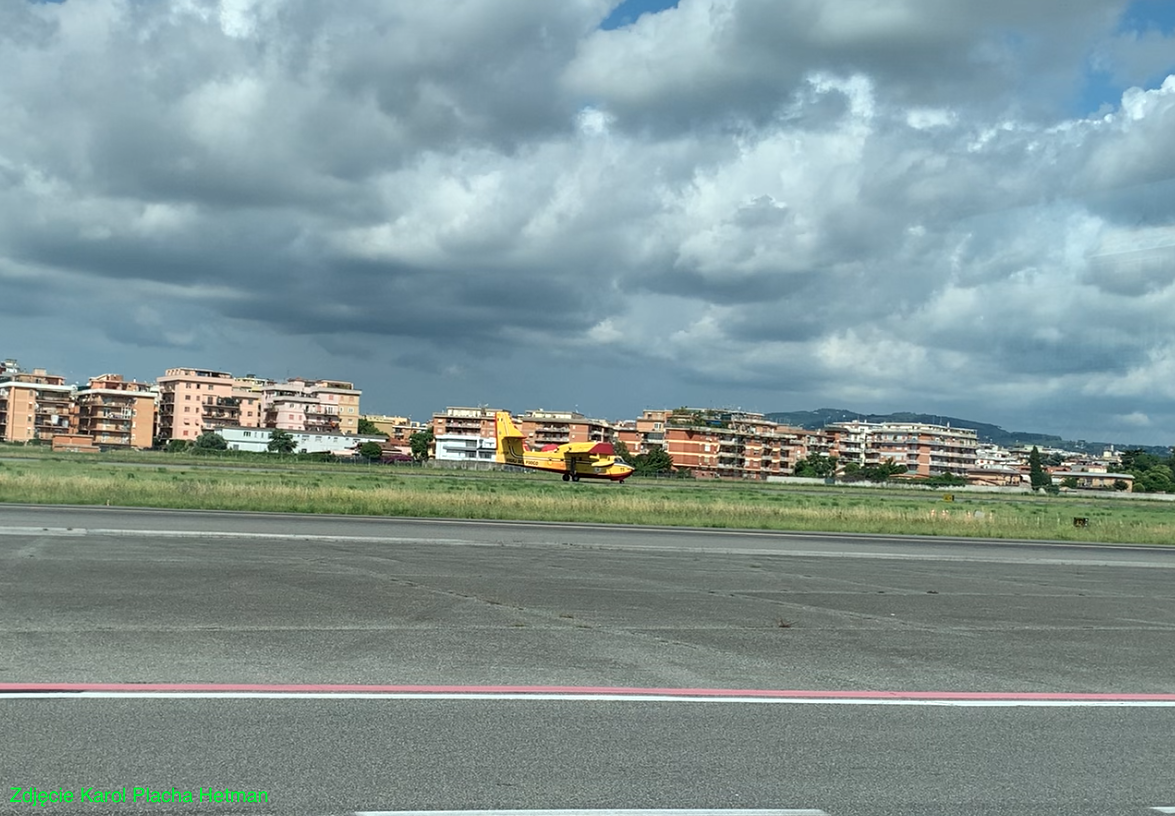Roma 2023-06-14
Canadair CL-415 specialized aircraft for firefighting and SAR tasks.
The Canadair CL-415 is an aircraft specially developed as a firefighting aircraft using dropped water bombs. The aircraft belongs to amphibious aircraft, i.e. it is capable of landing both on land (RWY) and on water. The aircraft is specifically designed for aerial firefighting, but can perform other tasks as well; search and rescue (SAR missions) and utility transport.
Canadair CL-415 is derived from the design of the aircraft, the amphibious Canadair CL-215 Scooper, which was produced in the period 1969 – 1986 by Canadair, and in the period 1986 – 1990, after ownership changes by Bombardier. The CL-215 aircraft made its first flight in 1966. By 1990, 125 were built.
The CL-215 design, however, became obsolete and a revised aircraft was developed, with a modified airframe and powerplant. First of all, internal combustion engines were replaced with turboprop engines. In 1990, the new aircraft was designated Bombardier 415 (Canadair CL-415). Then, after further changes in ownership of the manufacturer, the designation was changed to De Havilland Canada DHC-415/DHC-515. Viking Air also participated in the production process. Generally, the name "Super Scooper" was used for the aircraft.
Serial production of the CL-415 lasted from 1993 to 2015, and the CL-514 version from 2022. Even in 2003, a modification of the aircraft was carried out, which, however, did not change the designation of the structure. In 2015, the rights to manufacture the aircraft were transferred to Viking Air. At that time, the designation of the aircraft was changed to CL-515, and then to the designation DHC-515 Firefighter. The aircraft production line was moved to Calgary, Alberta.
Development of the Cl-415 aircraft.
Already in 1987, modernization of CL-215 aircraft was carried out by replacing piston engines with turboprop engines. Mainly Pratt & Whitney Canada PW123AF engines were installed. These engines greatly improved the design’s performance. These aircraft were designated CL-215T. In addition, the aircraft received a modernized control system, new avionics, and additional aerodynamic elements. At that time, it was decided not to launch serial production of aircraft with turboprop engines, because it was considered that the demand for these aircraft was low, and the price was 30% higher.
On December 6, 1993, the CL-415 prototype made its first flight, and by 1994, serial production began. An advertising flight was also made, during which the aircraft visited 21 countries. Order placed for 37 units for users in: Canada, France, Italy, Spain. A total of 95 examples were built and in 2015, the production line was closed. But in 2022, production has restarted, with 15 to 22 machines on order.
Let’s also remember that Bombardier invested a lot of money in the CSeries airliner, which, however, did not gain many orders, and eventually the CSeries program was taken over by Airbus. With all this, Viking Air, which produced spare parts for Canadair aircraft, was in a good financial position and decided to keep the CL-415/CL-515 program on offer. Viking Air acquired the licensing rights for $36.9 million. The company also built a CL-415/CL-515 simulator for crew training, especially in waterdrop. The simulator has been certified by the European Aviation Safety Agency (EASA).
CL-415/CL-515 aircraft in their class are the best machines in the world, they are reliable and require minimal maintenance for one hour of flight. The manufacturer ensures a constant supply of spare parts.
CL-415 design.
The CL-415 aircraft is a high-wing aircraft with an all-metal structure. Mainly aluminum alloys are used which have been chemically treated for protection against salt water. It is powered by two turboprop engines. The aircraft is equipped with an efficient water refilling system in the fuselage tank and a precise water drop system. The drop of water is carried out in the form of a water bomb or over an extended period of time. The equipment of the aircraft allows for precise localization of the fire and precise aiming at the target from any direction. Compared to its CL-215 predecessor, the CL-415 aircraft has an increased water intake payload and increased speed for improved efficiency.
Winglets are mounted on the wingtips to improve aircraft stability and reduce induced drag. Additional stabilizing surfaces were mounted on the horizontal tail.
The CL-415 can take up to 6,140 liters (1,350 imp gal; 1,620 US gal) of water from a nearby water source. If necessary, chemicals can be added to the water to better adhere the water to tree branches or create foam. The water tank has a complicated shape and is located under the floor of the hold and in the sides of the airframe.
The plane has good flight characteristics as well as good behavior on the water. The CL-515 version holds up to 7,000 liters (1,850 US gallons) and has a filling time of 14 seconds. The CL-415 needs a distance of 1,340 m (4,400 ft) to descend from 15 m into the water, take on water and rise to a height of 15 m. Tank fill time is 12 seconds. The aircraft then flies at 70 knots (130 km/h; 81 mph). The aircraft may take on water during a gentle turn. The cargo hold of the aircraft provides for taking additional crew members, two lifeboats and other rescue equipment necessary for SAR operations.
The CL-415 aircraft is powered by two Pratt & Whitney Canada PW123AF engines, 2 x 1,775 kW.
Data T-T CL-415:
Span 28.38 m (93.11 ft). 20.4 m (66 ft 11 in) long. Height 9.01 m (29.55 ft). Wing area 100 m2 (1080 square feet). Curb weight 13,608 kg (30,000 lb). Gross weight 21,319 kg (47,000 lb). Fuel capacity 4,650 kg (10,250 lb) 5,812 liters (1,535 US gal; 1,278 st gal). Hold volume 35.6 m3 (1,260 cu ft). Water capacity 6,137 liters (1,350 imp gal; 1,621 US gal) (water bombing), up to 18 paratroopers, up to 2,903 kg (6,400 lb) of cargo. Crew of two pilots.
Top speed 359 km/h (223 mph, 194 kn). Cruising speed 333 km/h (207 mph, 180 kn). Minimum speed 126 km/h (78 mph, 68 kn). Ferrying range 2,427 km (1,508 mi, 1,310 nmi). Climb rate 5.9 m/s (1,170 ft/min). Takeoff length 783 m (2,569 ft) (land), 814 m (2,671 ft) (water).
The Pratt & Whitney Canada PW123AF turboprop engines, 2 x 1,775 kW (2 x 2,380 hp) each. Hamilton Sunstrand 14SF-19 4-bladed propellers, 3.97 m (13 ft 0 in) diameter.
Written by Karol Placha Hetman


